Related Research Articles
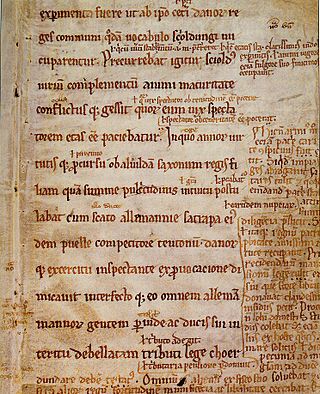
Gesta Danorum is a patriotic work of Danish history, by the 12th-century author Saxo Grammaticus. It is the most ambitious literary undertaking of medieval Denmark and is an essential source for the nation's early history. It is also one of the oldest known written documents about the history of Estonia and Latvia.
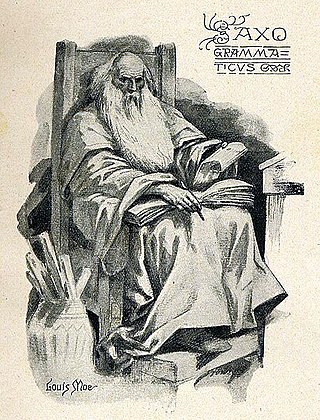
Saxo Grammaticus, also known as Saxo cognomine Longus, was a Danish historian, theologian and author. He is thought to have been a clerk or secretary to Absalon, Archbishop of Lund, the main advisor to Valdemar I of Denmark. He is the author of the Gesta Danorum, the first full history of Denmark, from which the legend of Amleth would come to inspire the story of Hamlet by Shakespeare.
Lotherus (Lother) was one of the earliest kings of Denmark according to Saxo Grammaticus's Gesta Danorum.
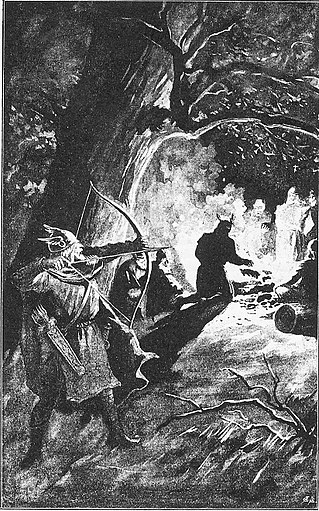
Palnatoke or Palnatoki, sometimes written Palna-Toki or Palna Toki, was a legendary Danish hero and chieftain of the island of Fyn. According to the Jómsvíkinga saga, Palnatoki founded the brotherhood of Jomsvikings and established its laws.
Christiern Pedersen was a Danish canon, humanist scholar, writer, printer and publisher.
Glæsisvellir was a location in Jotunheim in Norse mythology. It is mentioned in sources such as Bósa saga ok Herrauds, Hervarar saga, Þorsteins þáttr bæjarmagns and Helga þáttr Þórissonar.

Anders Sørensen Vedel was a Danish priest and historian. He translated the Gesta Danorum by Saxo Grammaticus into Danish in 1575, and published the influential "Hundredvisebogen" in 1591.
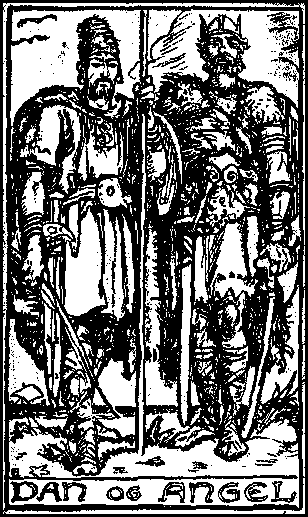
Dan I was the progenitor of the Danish royal house according to Saxo Grammaticus's Gesta Danorum. He supposedly held the lordship of Denmark along with his brother Angul, the father of the Angles in Angeln, which later formed the Anglo-Saxons in England.

Humblus was one of the earliest kings of Denmark according to Saxo Grammaticus's Gesta Danorum.
Skjöldr was among the first legendary Danish kings. He is mentioned in the Prose Edda, in Ynglinga saga, in Chronicon Lethrense, in Sven Aggesen's history, in Arngrímur Jónsson's Latin abstract of the lost Skjöldunga saga and in Saxo Grammaticus' Gesta Danorum. He also appears in the Old English poem Beowulf. The various accounts have little in common.

Gram was one of the earliest legendary Danish kings according to Saxo Grammaticus' Gesta Danorum. His history is given in more detail than those of his predecessors. Georges Dumézil argued that Gram was partially modelled on the god Thor, in particular his defeat of Hrungnir and subsequent encounter with Gróa.
Dan II is one of the legendary Danish kings, the son of Offa of Angel, described in Saxo Grammaticus' Gesta Danorum.
Dan III is one of the legendary Danish kings described in Saxo Grammaticus' Gesta Danorum.
Frotho II is one of the legendary Danish kings described in Saxo Grammaticus' Gesta Danorum.
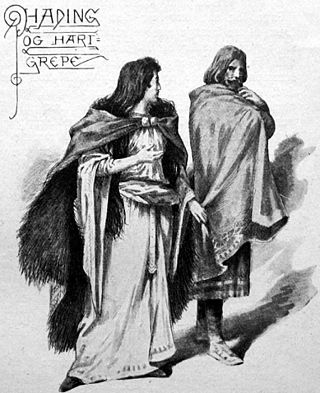
Hadingus was one of the earliest legendary Danish kings according to Saxo Grammaticus' Gesta Danorum, where he has a detailed biography. Georges Dumézil and others have argued that Hadingus was partially modelled on the god Njörðr.
Fridlevus I is one of the legendary Danish kings described in Saxo Grammaticus' Gesta Danorum.

Runamo is a cracked dolerite dike in Sweden that was for centuries held to be a runic inscription and gave rise to a famous scholarly controversy in the 19th century. It is located 2.7 km from the church of Bräkne-Hoby in Blekinge, in South-Sweden. For hundreds of years people said it was possible to read an inscription, and learned men referred to it.
Rusla, also known as the "Red Woman" from Middle Irish Ingean Ruagh, was a legendary Norwegian shield-maiden mentioned in the Gesta Danorum or "History of the Danes" of Saxo Grammaticus and in the Irish annals. According to Saxo, Rusla was the daughter of a fifth or sixth century king of Telemark called Rieg, and sister of Tesandus (Thrond), who was dispossessed of his throne by a Danish king named Omund. Rusla formed a pirate fleet to attack all Danish ships as revenge for the affront to her brother. Rusla was always accompanied by another woman, Stikla, who was her deputy in all raids. Stikla turned to piracy to avoid marriage, and her name is the origin of the Norwegian city of Stiklestad.
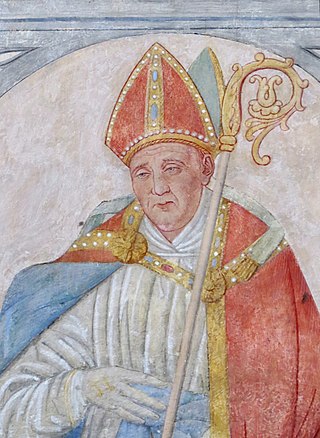
William of Roskilde was a Danish prelate of the Roman Catholic Church who served as the Bishop of Roskilde in Denmark from about 1060.
Frotho III was a legendary king of Denmark. His life was recounted in book 5 of Gesta Danorum by Saxo Grammaticus, and in the Skjöldunga saga.
References
- Davidson, Hilda Ellis (ed.) and Peter Fisher (tr.) (1999). Saxo Grammaticus : The History of the Danes : Books I-IX. Bury St Edmunds: St Edmundsbury Press. ISBN 0-85991-502-6. First published 1979-1980.
- Elton, Oliver (tr.) (1905). The Nine Books of the Danish History of Saxo Grammaticus. New York: Norroena Society. Available online
- Olrik, J. and H. Ræder (1931). Saxo Grammaticus : Gesta Danorum. Available online